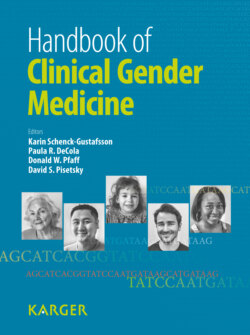Читать книгу Handbook of Clinical Gender Medicine - Группа авторов - Страница 60
На сайте Литреса книга снята с продажи.
Sex Determination Chromosomes, Embryology, Hormones, and Receptors
ОглавлениеSex differentiation can be divided into 3 phases. Chromosomal sex is established at fertilization. Male sex differentiation almost always occurs if a functioning sex-determining region of the Y chromosome (SRY) gene is present. Two functional X chromosomes are necessary for reproductive females. Deletions from Xp or Xq, or from both, have indicated that genes from both arms of the X chromosome are involved in ovarian differentiation and maturation. On Xq in the paracentromeric region there is a location for androgen receptor protein and for X inactivation. In female mammals this is important for dosage inactivation of one X chromosome. Random inactivation is fixed for each cell, and its progeny, so that each female is a mosaic of paternal and maternal active X chromosomes.
The second step is differentiation of the gonads. Development of the reproductive tract begins in the embryo and is sex independent. In the human, the embryonic period spans weeks 2-8 of gestation. Until the fetus reaches 50 mm in CR length (9 weeks), the genitalia in both sexes look identical. Germ cells appear in the epiblast and migrate through the primitive streak and then to the base of the allantois. Along the wall of the hindgut, they migrate to the urogenital ridge. In the primitive gonad, primitive sex cords displaying corticomedullary architecture are formed by the end of the 6th week. The third step is development of the phenotypic sex, comprising internal and external genitalia. It includes gonadal development. Testis formation starts with Sertoli cell proliferation and differentiation under the influence of SRY, which must reach a threshold level in a defined temporal window; otherwise, the ovary-determining pathway begins. Sertoli cells surround primitive germ cells and induce mitotic arrest. The formation of testis cords from the medullary region of the primitive sex cord is the first visible sign of male differentiation. From the 6th to the 12th week, the organotypic patterns of the testis are established. Proliferation of Sertoli cells leads to the characteristic enlargement of the early testis. The number of Sertoli cells appears to be closely related to the number of germ cells, testicular size, and sperm count in later life. During the evaluation of a newborn with ambiguous genitalia, small gonads can indicate gonadal dysgenesis. Later, this finding may explain a delayed onset of puberty or male subfertility.
Vascularization of the testis starts with formation of a large artery under the coelomic surface. The coelomic vessel is formed following SRY expression, with a role for androgen transport suggested. Later, anastomoses to the arteria ductus deferentis and arteria cremasterica are formed, and the blood-testis barrier is created by the Sertoli cells. The tunica albuginea comprises mesenchymal tissue forming a thick fibrous capsule. It is a specialized structure in both sexes. In the male, it forms the testicular septations and the mediastinum testis. It is involved in the compartmentalization of the testis, and laminin deposition can be demonstrated at early stages. The tunica contains contractile elements. It promotes the transport of spermatozoa in adult life, maintains the interstitial pressure, and controls testicular blood flow.
The tunica albuginea of the ovary appears to have a regulatory role in the maintenance of the germ cells. The tunica of the testis is thicker than that of the ovary. In newborn boys, the tunica is white or bluish, in newborn girls it is yellow or brown, and follicular cysts can be seen.
Local androgen action is required for the differentiation of the epididymis and the vas.
Ovarian formation starts in the early fetal stage, described by Jirasek [1] as extending from the end of the embryonic period (the first week) until week 16 of gestation. During the first week, oogonia at the center of the gonad enter meiosis which rapidly extends peripherally to reach oogonia at the surface of the ovary. Two X chromosomes are not needed at this point. After 16 weeks, primary follicles begin to form in the ovary and are characterized by an oocyte. These are completely surrounded by a single layer of follicular cells and connective tissue. If the surround is incomplete, oocytes degenerate. Formation of primary follicles requires two X chromosomes. At the age of viability (24 weeks) some ovarian follicles consist of growing oocytes surrounded by several layers of granulosa cells. Stroma surrounding the growing follicles organizes itself into theca interna and externa. At the end of gestation some follicles become vesicular, degenerate, and disappear from the ovary within 6 months of birth. They present again at the onset of puberty. They constitute an organotypic pattern and are considered indicators of the presence of germ cells. Absence of germ cells is compatible with testicular development, but without germ cells ovary development does not take place and a streak gonad will result.
The gubernaculum and the suspensory ligaments are relevant for the position of the gonad. Incomplete regression of the caudal suspensory ligament may contribute to the abdominal position of the gonads in some patients with XY disorders of sex development (DSD). In newborns with ambiguous genitalia, ultrasound of the inguinal region and the lower abdomen is the first step. If no gonad is found, laparoscopy should be considered.
